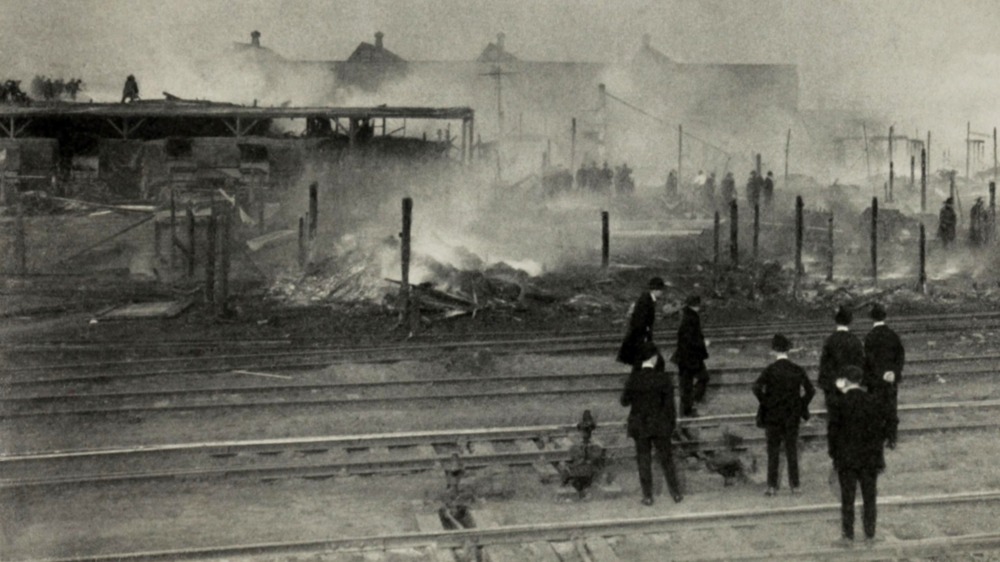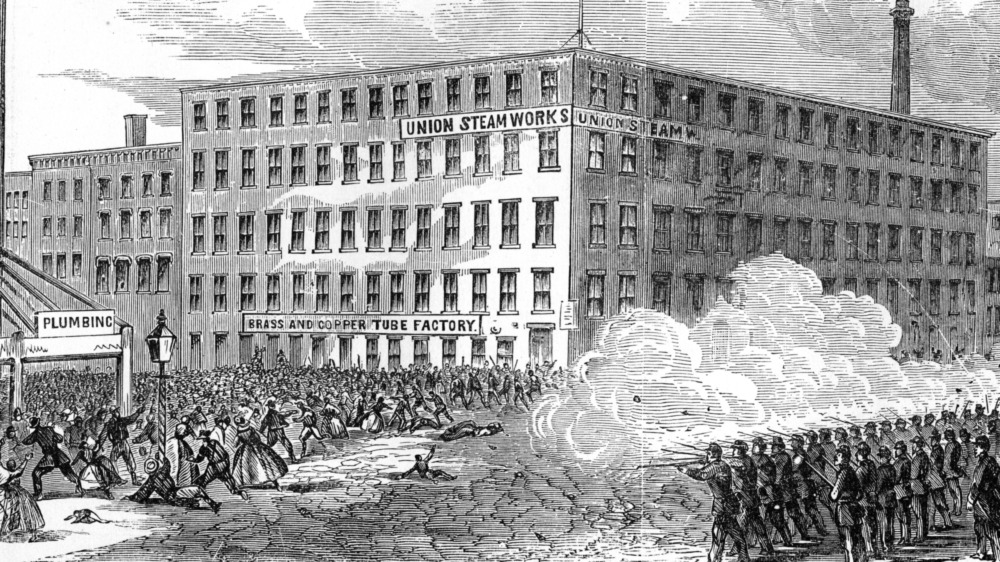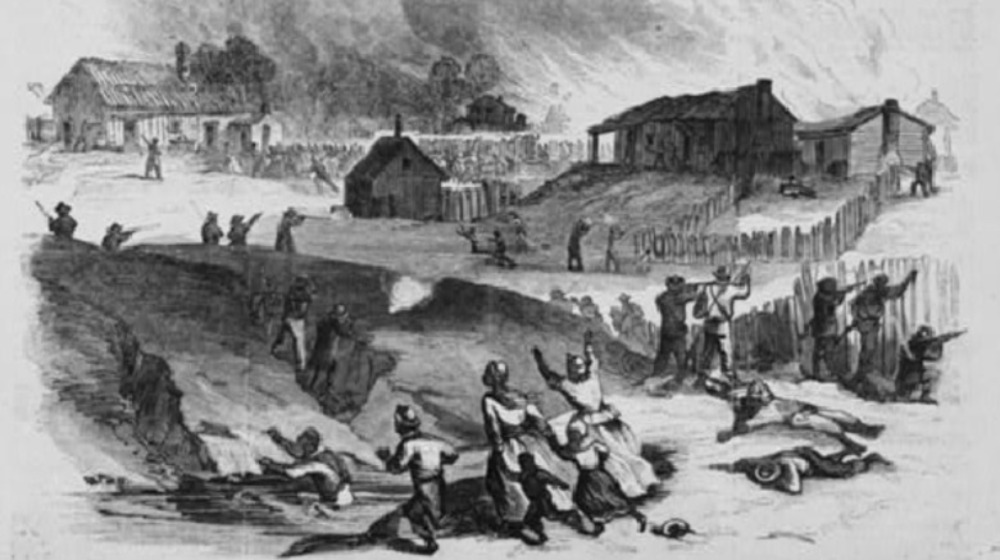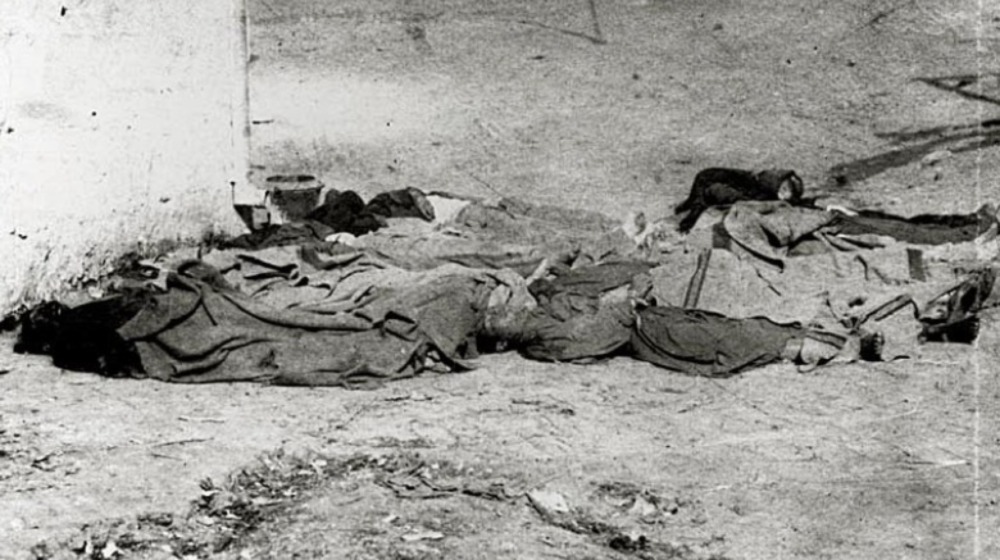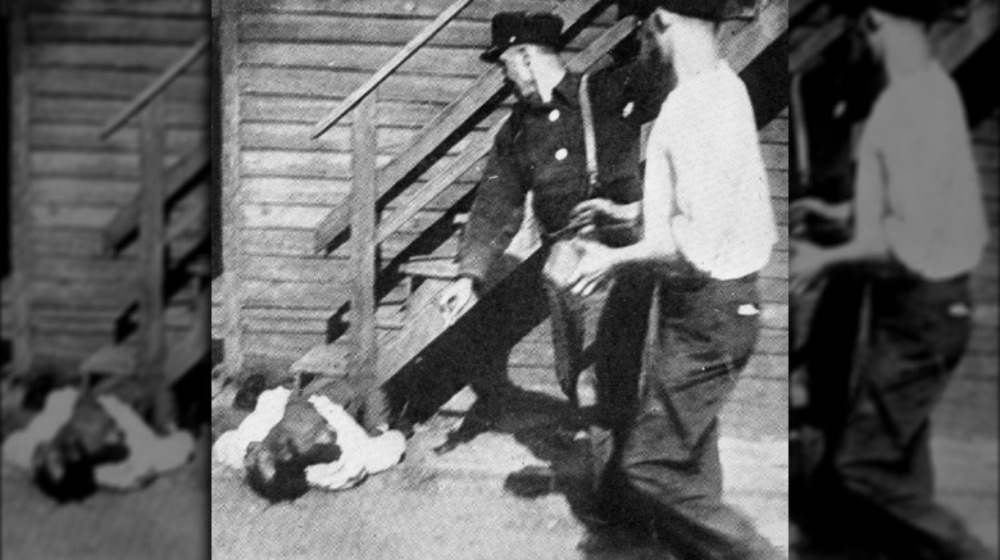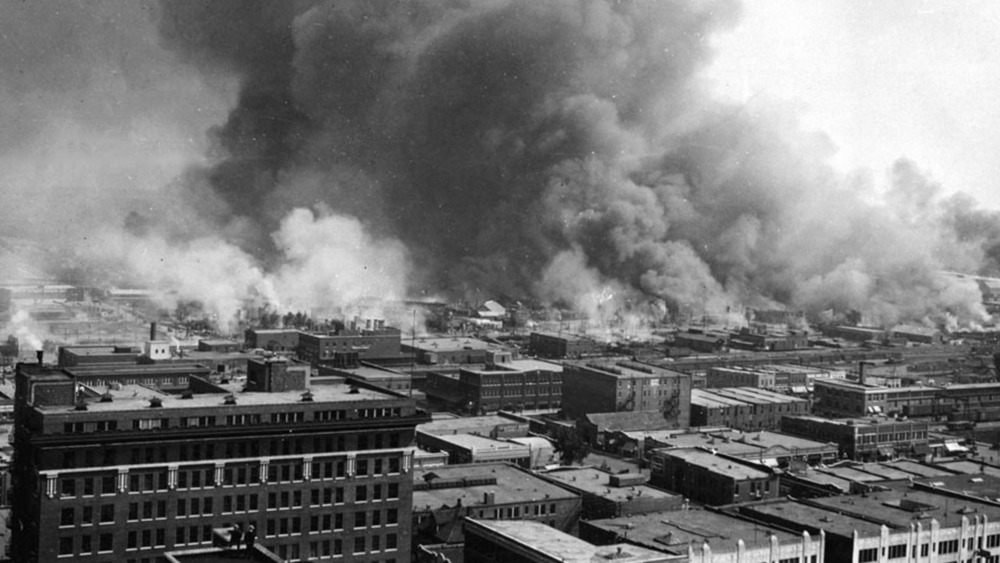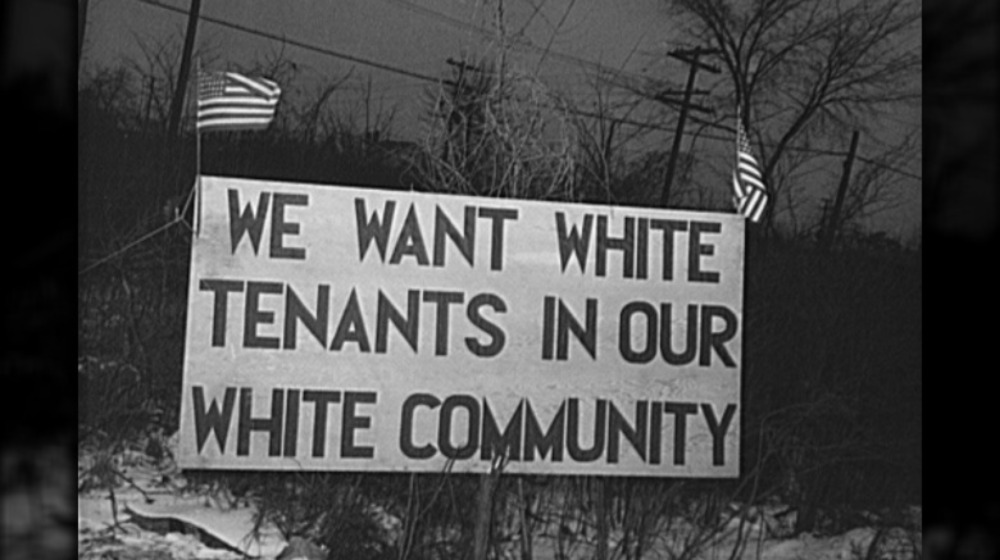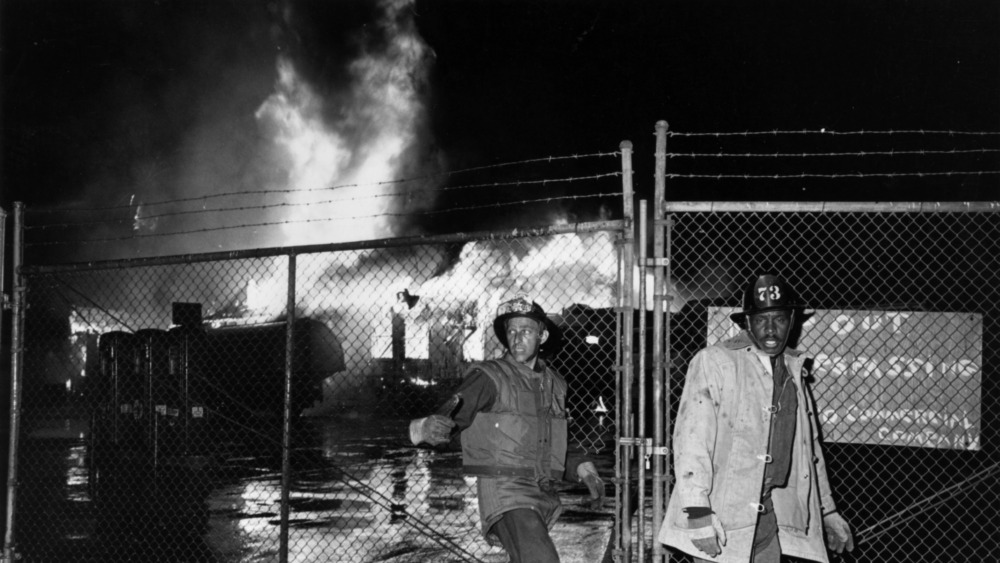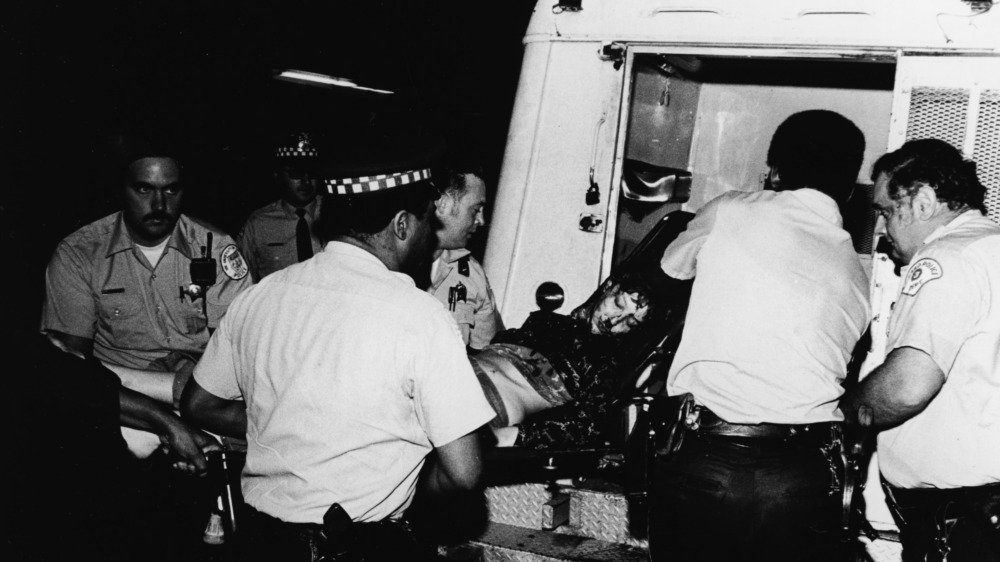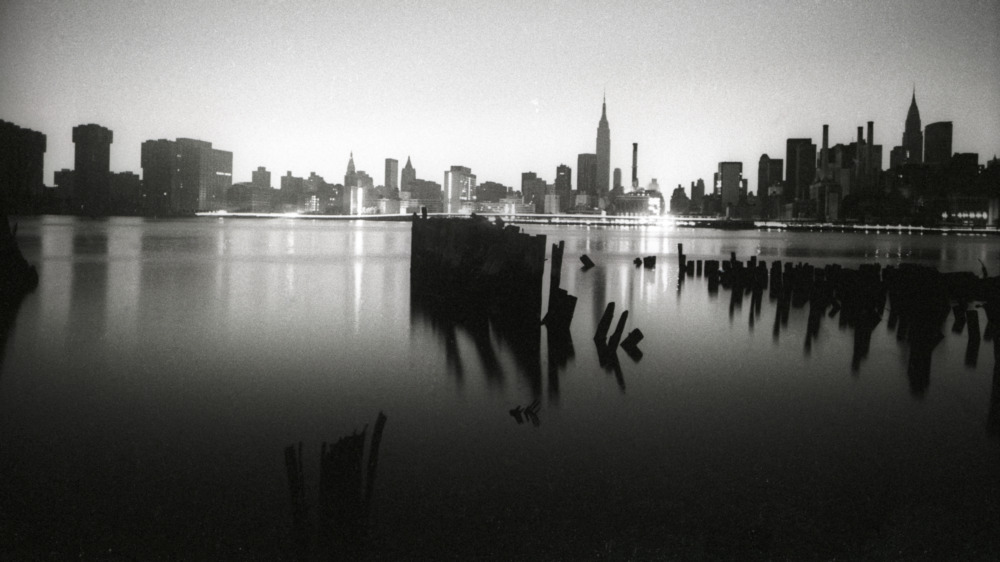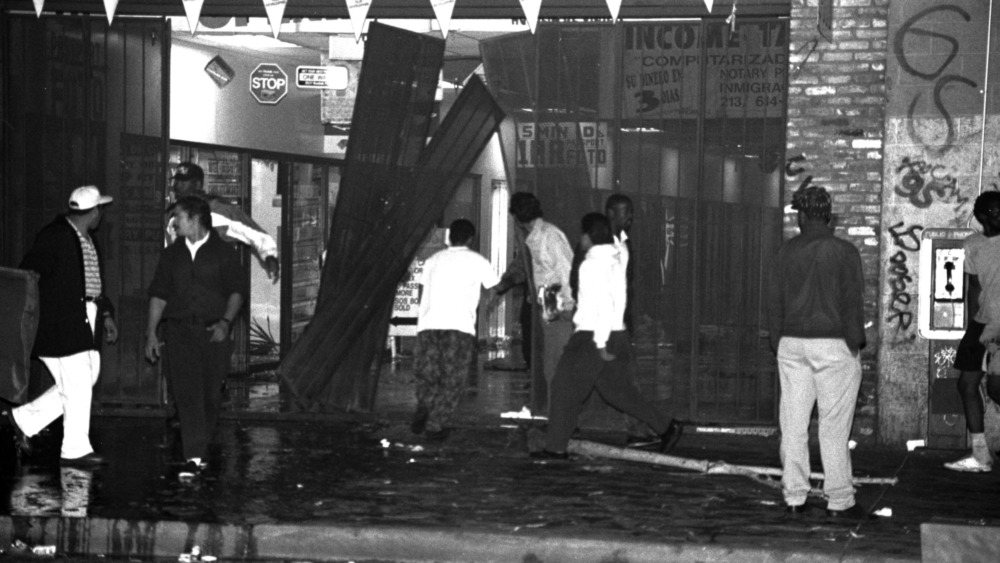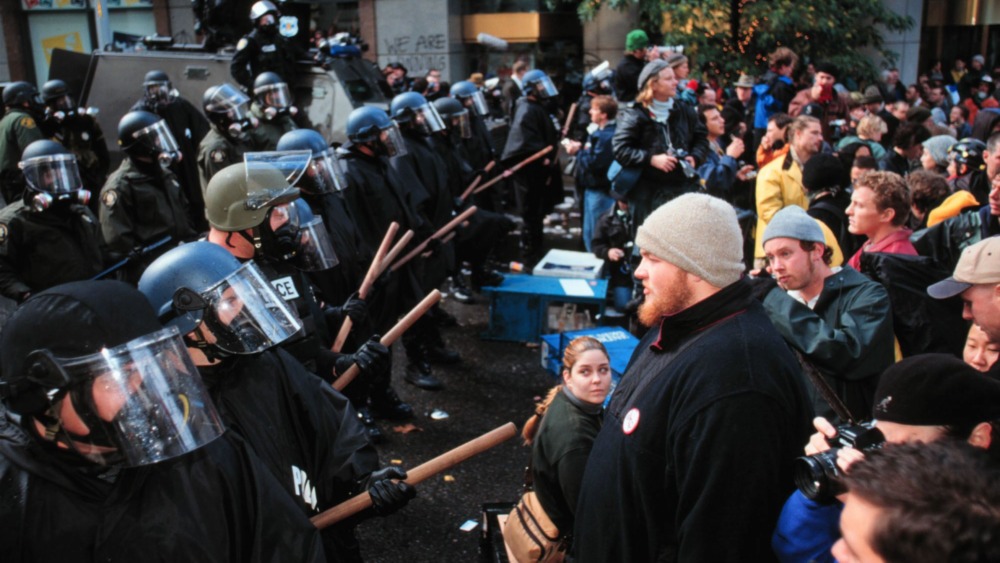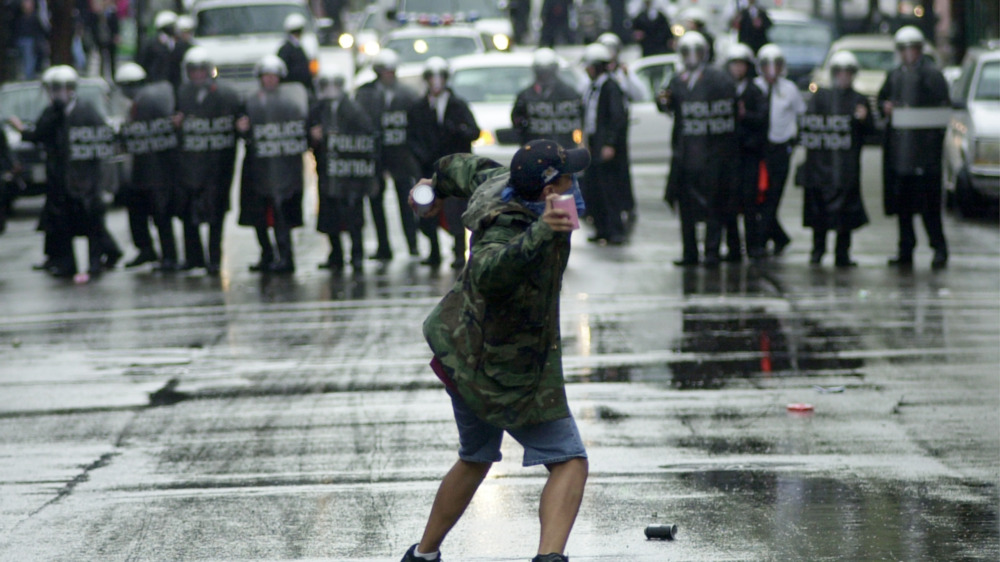The Most Disastrous Riots In American History
America has a pretty long history of civil unrest. To be fair, it's not like that's a uniquely American thing (it's really not), but there are certain points in history that are really heavily marked with protests and riots and a ton of social tension. And there are certain problems that have just managed to persist, no matter how many years go by.
That said, not all riots go the same way, and so it's sort of hard to say what exactly makes a riot the most disastrous. Death toll? Injuries? Property damage? Something else? And, many of these riots relate to issues that are still very much a problem as of 2021, like police brutality and racism in general, making their context in history scarily relevant.
Here's a list of some pretty notable riots in American history, all known for being pretty bad in some outstanding way.
The New York City Draft Riots
The Civil War seems clear cut — North vs. South, freedom vs. slavery — but it wasn't. As History explains, New York wasn't all that invested. The South was a huge trade partner, but there was more than that.
The Emancipation Proclamation just worsened existing problems. The Irish population still supported slavery, and they, along with the Germans, feared what would happen to their jobs when freed slaves escaped north (via the University of Chicago). The real problem hit when a draft went into effect. It came with a loophole that allowed only the wealthy to pay their way out of fighting, so most people suddenly had to fight for the rights of African Americans whom they didn't care for and also were exempt from the draft (since they weren't citizens).
The first draft lottery came on July 11, 1863. The city was silent for 24 hours, then the rioting started. Rioters initially attacked government buildings, but then the violence turned from politically fueled to racially fueled, with rioters attacking African Americans and anyone who showed them support (including abolitionists and businesses that employed Black workers). They lynched and beat men and set fire to an orphanage full of children. All told, the riots lasted a week, causing millions of dollars in damage and leaving thousands homeless. The death toll was publicly reported as 119, though other estimates range as high as 1,200, ranking it as the deadliest riot in all United States history.
The Memphis Riot of 1866
The end of the Civil War brought with it Reconstruction, and Reconstruction brought with it new legislation. Sounds good on paper. But in reality, things were a little more shaky.
Memphis was a good example of that. Rife with tension, according to The Atlantic, things ended up coming to a head in May 1866 when a white police officer tried to arrest a Black veteran (via BlackPast). More Black citizens showed up to try and resist the arrest, and then things just escalated. Not only Black soldiers but also Black civilians became targets of looting and violence — men, women, and even children were shot and killed by the white mob, their houses set on fire, sometimes with them still inside.
To make matters worse, the rioters weren't just angry civilians but also police and firemen who actively supported and took part in the killing, beating, and looting. Even government officials officially endorsed the riot (or massacre, as it's sometimes labeled — there was actually pretty little resistance from the Black victims). Mayor John Park did basically nothing to stop the violence, which continued essentially unhindered over three days and only ended when an Army commander declared martial law.
Then, to top it off, despite nearly 50 deaths and almost 300 wounded, no one was arrested or tried. The incident did increase support for the 14th Amendment, but it's sort of a hollow victory, all things considered.
The Chinese Massacre of 1871
The late 1860s saw the rise of anti-Chinese sentiment, with newspapers calling the Chinese inferior, immoral, and barbaric, according to the Los Angeles Times. Sometimes, that led to violence, but nothing would quite top what happened when a shootout between rival Chinese gangs led to the death of a civilian in October 1871.
The streets of the so-called City of Angels turned far from heavenly. Hundreds of rioters took to the streets to attack the then-tiny Chinese population. They climbed roofs, hacking out holes to shoot the innocent people inside, or forced people out of their homes, just to beat and torture and kill them, sometimes in front of their children. People were dragged through the streets by their necks and lynched, their bodies hung up from awnings and sides of wagons. Then came the looting, the mob glad to help themselves to their victims' valuables (including a diamond ring, taken by cutting off a man's finger).
By the end, 19 people (10% of the Chinese population) were dead, most of their bodies laid out in the open, a gruesome display (via the Los Angeles Public Library). And a proud one, apparently, as newspapers hailed it "a victory of the patriots over the heathens," and convictions against the rioters getting dropped. The entire tragedy was basically forgotten, and anti-Chinese sentiment just continued to rise.
The Red Summer of 1919
As World War I raged, more African Americans moved up to the North and Midwest, filling vacated jobs (via The National WWI Museum and Memorial). So, the aftermath of the war was messy. White ex-soldiers resented Black workers for "stealing" their jobs and wanted to quell the growing Black middle class.
But Black veterans were also returning from the war, and according to History, they weren't going to take things lying down. They were ready to fight against segregation, and their white counterparts feared that.
That's when the riots started. During the Red Summer — named as such because of the blood that stained the streets all across the U.S. — mobs of white civilians formed at the slightest provocation, while Black veterans defended their communities. Days-long riots raged through at least 26 cities across the country, with major cities like Chicago and Washington D.C. seeing some of the worst violence. Lynchings rose in number, and hundreds of people died (at least — there's no exact record), while thousands were injured over the course of about eight months. All the while, the government did little to help, President Woodrow Wilson more concerned with the American reputation on the world stage than back home.
The Tulsa Race Riot
As History says, things started on May 30, 1921, with a Black teenager — Dick Rowland — entering an elevator, and the female elevator operator, Sarah Page, screaming as Rowland fled. After Rowland's arrest, an angry white mob showed up, trying to take Rowland and deal with him themselves. A group of about 75 Black men arrived at the courthouse to help protect Rowland, only to be met with another white mob that outnumbered them 20 to one.
That's when the chaos started. Some white citizens were deputized and allowed to wreak havoc on the city's Black communities, burning down and looting businesses and homes, shooting people in their path — armed or not. The chaos lasted for about 18 hours, but the damage was immense — over a thousand houses burned, people were left homeless, and low estimates say that 36 people died. Higher and more recent estimates come closer to 300. To add insult to injury, the entire inciting incident turned out to be almost nothing. Rowland had probably just stepped on Page's foot.
And then the entire event was basically covered up. No memorials, and reports of it seemed to go missing from newspapers and police archives alike. No one really started looking into it until 50 years later (at which point people began to refer to it as a massacre instead of a riot).
The 1943 Detroit Race Riots
In the 1940s, Detroit was growing, and jobs in factories were multiplying, according to the Detroit Metro Times, drawing people — including a lot of African Americans — to the city. But Detroit couldn't handle it, and problems like massive housing shortages only worsened racial tensions. White residents wouldn't tolerate working or living next to African Americans (via Mt. Holyoke), and riots began.
The worst came on June 20, 1943. Fights broke out on Belle Isle, and even though police put an end to them, rumors started flying — Blacks had assaulted a white woman, or whites had beaten a Black woman. By the next morning, all parts of the city devolved into chaos, both sides attacking innocents, police tending to side with white rioters, spraying Black rioters with automatic gunfire while kind of encouraging whites to keep up their work (burning and overturning cars or beating motorcyclists into unconsciousness).
That said, some people tried to help and get the wounded to safety, though it didn't always end well. An Italian doctor was on his way to a housecall, only to be beaten to death by rioters. A lot of innocents were killed by guerilla warfare, shot, beaten, or even hit by cars, all while officials just sort of watched it happen.
Federal troops eventually curbed the violence, but only after it'd gone on for 36 hours and killed over 30 people.
The Watts Riot
The predominantly Black neighborhood of Watts in Los Angeles absolutely exploded on Aug. 11, 1965. Step brothers Marquette and Ronald Frye were stopped by police for drinking and driving (via History). Marquette was about to be arrested, and, long story short, a scuffle broke out between the group, both brothers and their mother getting arrested. A crowd had formed in the midst of this, and after some other altercations, grew angrier with the police.
That anger burst into a full riot in the evening, with attempts to quell the situation only making things worse. White drivers and motorists were pulled from their vehicles and attacked, and 50 square miles of Los Angeles turned to anarchy in just a few days. Burning buildings and cars, looted stores, police raids, molotov cocktails and bullets flying through the air — everything. Crowds fought with police and firefighters alike as buildings continued to burn.
After six days of riots involving 34,000 people, 34 were dead, over a thousand were injured, and the damage to a thousand buildings totalled $40 million. In the aftermath, the causes of the riots were chalked up to long-standing tension with the police and economic problems like poverty and unemployment (via Stanford University), and suggestions were made to fix those issues, but not a whole lot was really done in the end.
The 1968 Chicago Riot
To say that 1968 was a rough year in American history is an understatement. The Washington Post explains that the political scene was a mess, the entire country was reeling from the recent assassinations of Martin Luther King, Jr., and Robert F. Kennedy, and the Vietnam War was, well, the Vietnam War, and thus widely hated. Riots and peace protests were already gripping the nation, so when the Democratic National Convention was set to meet in Chicago, things were ready to boil over.
On August 28, police and soldiers were ready to meet protesters — maybe a little too ready. The protesters were unarmed, but the authorities met them with tear gas and clubs and a desire to send a message. They beat defenseless protesters senseless in direct view of reporters and threw tear gas into the crowds at parks and in hotel lobbies — they seemed to want people to see just how red they could turn the streets.
And it wasn't just the protesters they hurt, either. Random innocent bystanders, reporters, doctors — everyone was fair game and could be beaten bloody by the police, who also started arresting anti-war delegates for what seemed like no reason. Asking what was going on was even dangerous, those who questioned things being arrested and beaten themselves.
In the end, 600 people were arrested, 200 were injured, and everyone was just glad to get out.
The New York City Blackout
On July 13, 1977, New York City went dark. The famous, glittering skyline disappeared as three bolts of lightning caused a cascade of power grid failures (via Daily News). At first, it was almost exciting. But then, burning trash cans began lighting the streets, and it seemed like the power had taken civilization with it.
People began looting. Everything. Everywhere. It was all free for the taking. Food, clothing, instruments, televisions, furniture, cars, you name it, people took it, yanking storefront grates off of buildings and smashing through windows. And anything they couldn't take, they destroyed — at least, if they hadn't already set fire to the building and bathed the streets in an orange glow.
Twenty-five hours later, the lights came back and the smoke (of about a thousand fires) cleared, putting an end to the chaos, which had injured 558 and caused $1 billion in damages. According to The Washington Post, politicians on the right called it a moral failing, even a reason to increase police brutality, and refused to consider that there was more at play.
Like the lasting effects of the 1975 fiscal crisis or outstanding social tensions, the young and/or poor had been living with no hope and little to look forward to, feeling powerless and forgotten by their government. Feeling like no one cared to help them, they saw the blackout as a way to help themselves and finally take back power (via TIME).
The Rodney King Riots
In March 1991, an African American man named Rodney King led police on a chase through the streets of Los Angeles. Intoxicated and uncooperative (but unarmed), King was eventually caught (via History), and then beaten — for 15 minutes straight as other cops just watched and commented.
An 89 second video of the incident went public, showing officers kicking and beating King with batons, even though he'd long since stopped resisting. King ultimately suffered skull fractures and permanent brain damage, and four officers were charged with excessive use of force (via NPR). It seemed like a clear case, easy convictions. But then, the four officers were acquitted a year later, on April 29, 1992.
The riots started within a few hours. Frustrated with a lot of pre-existing problems (high unemployment and crime rates and harassment by police), the large African-American population of South Los Angeles began targeting light-skinned motorists, dragging them out of their vehicles and beating them, sometimes within an inch of their lives. They blocked streets and looted, setting buildings ablaze. People defended themselves from the violence with shotguns, and order was only restored when the military intervened on May 1. More than 60 people died, thousands were injured, and there was almost $1 billion in damages from the thousands of buildings burned. It's marked as the worst U.S. civil disturbance of the 20th century and sparked conversations over police brutality.
The 1999 WTO Protests
In November 1999, Seattle was thrilled to host the World Trade Organization (WTO) meeting (via The Seattle Times). Even though, maybe, they shouldn't have been. The WTO was hotly contested by a variety of groups, united in their distrust of globalization. Trouble was brewing, but Seattle officials insisted they were prepared.
But they weren't. Protesters came out in droves, filling the streets and managing to shut down the opening ceremonies, keeping the secretary of state trapped in her hotel. A few anarchist groups took the opportunity to wreak havoc, smashing windows, lighting trash cans on fire, and damaging police cars (via Seattle PI). That said, most of the protests were actually peaceful, but the overwhelmed police still fired rubber bullets and tear gas into the crowds (which Police Chief Norm Stamper later regretted — these were people just exercising their rights).
Over a hundred people were arrested, and trade negotiations ultimately broke down (actually kind of a success for the protesters). What's sort of sad, though, is that the protesters were basically right about globalization's dangers, but, according to The Atlantic, it didn't matter. Competition in China has increased unemployment in America, the FDA can barely keep up with regulations on imports, and globalization has raised carbon emissions (among other things). So, no this protest doesn't have a death toll, but what it was about is still scarily relevant.
The 2001 Cincinnati Riots
It was 2001, and Cincinnati was a ticking time bomb. According to the Oxford African American Studies Center, the city had already been a hotbed for riots and racial violence since the 1800s. Between 1995 and 2000, 15 Black men had died in police custody, and just between October 2000 and April 2001, there were four more deaths, all carried out by a police department that had allegedly engaged in racial profiling for over 30 years (via MSNBC).
So tensions were high, and the city just needed a spark to blow it all to pieces. That came in early April 2001, when 19-year-old Timothy Thomas was killed by a police officer. Thomas was unarmed, and when protesters at city hall couldn't get answers for his death, the rioting began. Starting on April 9 and spanning four days, rioters took out their frustrations on the police, throwing rocks and garbage, and breaking into the police station. Eventually, things escalated further — vandalism, destroying street vendor carts, smashing windows of banks or stores for loot, and beating white motorists that passed by. The rest of the city was terrified, and the institution of a curfew, as well as the presence of state troopers, brought the riots to an end.
All told, the riots caused $3.6 million in damage and is one of the largest since the Rodney King Riots nine years earlier (via BlackPast), again bringing police brutality into the public eye.
